Thor has died in Marvel Comics, and Mjolnir has died along with her. The story of Jane Foster's Thor is over as of The Mighty Thor #705. But Jane isn't the only one to face death and destruction in this comic. In order to deal with the terrible threat of the Mangog, she must pay a price that would cause any Thor to tremble. She must sacrifice Mjolnir.
It's a fitting end to Jason Aaron's arc, with Jane realizingknows that losing the enchanted hammer will force her to revert to her human form - and she knows her human form cannot survive that transition. But she chooses it nonetheless, chaining the Mangog to Mjolnir, and then tossing the hammer into the heart of the sun. The Odinson watches in horror, knowing what she's just done. "You killed Mjolnir," he cries out in his grief. And then he realizes the implications; that Jane has also killed herself.
RELATED: Thor's Lost Brother Returns To Marvel Comics (Are Movies Next?)
Thor Odinson does not believe Mjolnir could survive the sun. But if he's right, Jane's action may well have just begun the next chapter of Mjolnir's story.
The Secret History of Mjolnir
Jason Aaron has always liked to play the long game. He began to tease the Mangog's return all the way back in 2013, for example. That means no issue stands in isolation; rather, it has to be placed in context. That's most certainly the case with The Mighty Thor #705, which seems likely to be only the next step in Aaron's ongoing narrative.
In The Mighty Thor #12, Aaron revealed Mjolnir's secret history. Jane Foster headed to the Halls of the All-Knowing, where she learned that Mjolnir's story span back to the days of creation itself. In those ancient times, a cosmic force known as the God Tempest ravaged the cosmos. "It began with the first wind that ever howled down out of the void," the librarian explained, "and it had been growing in size and fury with each subsequent eon. They called it the God Tempest. The Mother of Thunder."
This powerful storm was a sentient being in its own right, and it brought judgment to the worlds. Stars were snuffed out like candles before it, worlds were torn from their orbits, and comets were thrown off course. Finally, the God Tempest approached Asgard, where it was opposed by Odin himself. Against all the odds, the All-Father succeeded in binding the God Tempest into a chunk of Uru, which he had the Dwarfs forge into the enchanted Mjolnir.
If Mjolnir has indeed been destroyed, if the Uru has melted inside the sun's fire, then the God Tempest is likely free once again.
Will the God Tempest be an Ally or an Enemy?
The God Tempest would be a powerful force, and an ambiguous one - neither truly friend nor foe. Aaron's run has seen the God Tempest reveal its character and nature through its actions; it seems to stand in defense of the vulnerable, and yet is willing to judge the gods. It brought Jane into conflict with Odin, and yet persuaded her to wield it one last time in order to save him.
Given the God Tempest's purposes have proved so inscrutable, it's impossible to predict what role this sentient super-storm will play going forward. Will it prove to be an ally for Thor Odinson once again, as it was for so many years? After all, The Mighty Thor #12 implied that the storm itself chose Thor, long before Odin gifted Mjolnir to his son. Or will it instead be a dangerous force, opposing the Asgardians' new direction in Marvel's "Fresh Start" relaunch?
One thing seems certain; to a long-term planner like Jason Aaron, Mjolnir's destruction is just the next chapter in his story. Aaron rewrote Mjolnir's history for a reason, and that reason will eventually be revealed.
MORE: Chris Hemsworth Shares Mjolnir In Memoriam Video
The Mighty Thor #705 is available now from Marvel Comics.



